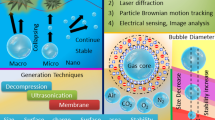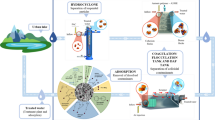Abstract
A novel, functionalized bubble surface can be obtained in dissolved air flotation (DAF) by dosing chemicals in the saturator. In this study, different cationic chemicals were used as bubble surface modifiers, and their effects on natural organic matter (NOM) removal from river water were investigated. NOM in the samples was fractionated based on molecular weight and hydrophobicity. The disinfection byproduct formation potentials of each fraction and their removal efficiencies were also evaluated. The results showed that chitosan was the most promising bubble modifier compared with a surfactant and a synthetic polymer. Tiny bubbles in the DAF pump system facilitated the adsorption of chitosan onto microbubble surfaces. The hydrophobic NOM fraction was preferentially removed by chitosan-modified bubbles. Decreasing the recycle water pH from 7.0 to 5.5 improved the removal of hydrophilic NOM with low molecular weight. Likewise, hydrophilic organic compounds gave high dihaloacetic acid yields in raw water. An enhanced reduction of haloacetic acid precursors was obtained with recycle water at pH values of 5.5 and 4.0. The experimental results indicate that NOM fractions may interact with bubbles through different mechanisms. Positive bubble modification provides an alternative approach for DAF to enhance NOM removal.

Similar content being viewed by others
References
Elmahdy A M, Mirnezami M, Finch J A. Zeta potential of air bubbles in presence of frothers. International Journal of Mineral Processing, 2008, 89(1–4): 40–43
Bratskaya S, Schwarz S, Chervonetsky D. Comparative study of humic acids flocculation with chitosan hydrochloride and chitosan glutamate. Water Research, 2004, 38(12): 2955–2961
Edzwald J K, Haarhoff J. Dissolved Air Flotation For Water Clarification. New York: AWWA and McGraw Hill, 2012
Al-Zoubi H, Ibrahim K, Abu-Sbeih K. Removal of heavy metals from wastewater by economical polymeric collectors using dissolved air flotation process. Journal of Water Process Engineering, 2015, 8: 19–27
Miranda R, Negro C, Blanco A, O. Internal treatment of process waters in paper production by dissolved air flotation with newly developed chemicals. 1: Laboratory tests. Industrial & Engineering Chemistry Research, 2009, 48(4): 2199–2205
Saarimaa V, Sundberg A, Holmbom B, Blanco A, Fuente E, Negro C. Monitoring of dissolved air flotation process by focused beam reflectance measurement. Industrial & Engineering Chemistry Research, 2006, 45(21): 7256–7263
Wang W D, Fan Q H, Qiao Z X, Yang Q, Wang Y B, Wang X C. Effect of water quality on the coagulation performances of humic acids irradiated with UV light. Frontiers of Environmental Science & Engineering, 2015, 9(1): 147–154
Henderson R K, Parsons S A, Jefferson B. The potential for using bubble modification chemicals in dissolved air flotation for algae removal. Separation Science and Technology, 2009, 44(9): 1923–1940
Han M Y, Kim M K, Shin M S. Generation of a positively charged bubble and its possible mechanism of formation. Journal of Water Supply: Research & Technology-Aqua, 2006, 55(7–8): 471–478
Henderson R K, Parsons S A, Jefferson B. Polymers as bubble surface modifiers in the flotation of algae. Environmental Technology, 2010, 31(7): 781–790
Yap R K L, Whittaker M, Diao M, Stuetz R M, Jefferson B, Bulmus V, Peirson W L, Nguyen A V, Henderson R K. Hydrophobicallyassociating cationic polymers as micro-bubble surface modifiers in dissolved air flotation for cyanobacteria cell separation. Water Research, 2014, 61: 253–262
Rao N R H, Yap R, Granville A M, Stuetz R M, Henderson R K. Algae flotation using PosiDAF: A comparison of polymers as bubble surface modifiers. In: Proceeding of the 7th International Conference of Flotation in Water and Wastewater Systems. Toulouse: France, 2016, 168–175
Zhang M, Guiraud P. Colloidal gas aphrons in flotation separation of nanoparticles: bubble dispersion features and flotation performance. In: Proceeding of the 7th International Conference of Flotation in Water and Wastewater Systems. Toulouse: France, 2016, 134–142
Wang X M, Mao Y Q, Tang S, Yang H W, Xie Y F. Disinfection byproducts in drinking water and regulatory compliance: a critical review. Frontiers of Environmental Science & Engineering, 2015, 9 (1): 3–15
Kam S K, Gregory J. Charge determination of synthetic cationic polyelectrolytes by colloid titration. Colloids and Surfaces. A, Physicochemical and Engineering Aspects, 1999, 159(1): 165–179
Yang J X, Ma J, Song D, Zhai X D, Kong X J. Impact of preozonation on the bioactivity and biodiversity of subsequent biofilter under low temperature conditions-a pilot study. Frontiers of Environmental Science & Engineering, 2016, 10(4): 50–60
Kitis M, Karanfil T, Wigton A, Kilduff J E. Probing reactivity of dissolved organic matter for disinfection by-product formation using XAD-8 resin adsorption and ultrafiltration fractionation. Water Research, 2002, 36(15): 3834–3848
Hua G, Reckhow D A. Characterization of disinfection byproduct precursors based on hydrophobicity and molecular size. Environmental Science & Technology, 2007, 41(9): 3309–3315
Clesceri L S, Greenberg A E, Eaton A D. Standard Methods for the Examination of Water & Wastewater, 20th ed. American Public Health Association, 1998
Fan X J, Tao Y, Wei D Q, Zhang X H, Lei Y, Noguchi H. Removal of organic matter and disinfection by-products precursors in a hybrid process combing ozonation with ceramic membrane ultrafiltration. Frontiers of Environmental Science & Engineering, 2015, 9(1): 112–120
Jungwirth P, Tobias D J. Specific ion effects at the air/water interface. Chemical Reviews, 2006, 106(4): 1259–1281
Zhang W H, Zhang J Z, Zhao B, Zhu P H. Microbubble size distribution measurement in a DAF system. Industrial & Engineering Chemistry Research, 2015, 54(18): 5179–5183
Park S H, Padhye L P, Wang P, Cho M, Kim J H, Huang C H. Nnitrosodimethylamine (NDMA) formation potential of amine-based water treatment polymers: Effects of in situ chloramination, breakpoint chlorination, and pre-oxidation. Journal of Hazardous Materials, 2015, 282(23): 133–140
Calgaroto S, Azevedo A, Rubio J. Separation of amine-insoluble species by flotation with nano and microbubbles. Minerals Engineering, 2016, 89: 24–29
Azevedo A, Etchepare R, Calgaroto S, Rubio J. Aqueous dispersions of nanobubbles: generation, properties and features. Minerals Engineering, 2016, 94: 29–37
Fan M M, Tao D, Honaker R, Luo Z F. Nanobubble generation and its application in froth flotation (part I): nanobubble generation and its effects on properties of microbubble and millimeter scale bubble solutions. Mining Science and Technology, 2010, 20(1): 1–19
Miranda R, Nicu R, Latour I, Lupei M, Bobu E, Blanco A. Efficiency of chitosans for the treatment of papermaking process water by dissolved air flotation. Chemical Engineering Journal, 2013, 231: 304–313
Philippova O E, Korchagina E V. Chitosan and its hydrophobic derivatives: preparation and aggregation in dilute aqueous solutions. Polymer Science, Series A, 2012, 54(7): 552–572
Ma J, Jiang J, Pang S, Guo J. Adsorptive fractionation of humic acid at air-water interfaces. Environmental Science & Technology, 2007, 41(14): 4959–4964
Lenhart J J, Saiers J E. Adsorption of natural organic matter to airwater interfaces during transport through unsaturated porous media. Environmental Science & Technology, 2004, 38(1): 120–126
Ishida N. Direct measurement of hydrophobic particle-bubble interactions in aqueous solutions by atomic force microscopy: effect of particle hydrophobicity. Colloids and Surfaces. A, Physicochemical and Engineering Aspects, 2007, 300(3): 293–299
Zhang W Z, Chen X Q, Zhou J M, Liu D H, Wang H Y, Du C W. Influence of humic acid on interaction of ammonium and potassium ions on clay minerals. Soil Science Society of China, 2013, 23(4): 493–502
Winter B, Faubel M, Vacha R, Jungwirth P. Behavior of hydroxide at the water/vapor interface. Faraday Discussions, 2009, 474: 242–247
Kim H C, Yu M J. Characterization of natural organic matter in conventional water treatment processes for selection of treatment processes focused on DBPs control. Water Research, 2005, 39(19): 4779–4789
Li A, Zhao X, Mao R, Liu H, Qu J. Characterization of dissolved organic matter from surface waters with low to high dissolved organic carbon and the related disinfection byproduct formation potential. Journal of Hazardous Materials, 2014, 271: 228–235
Acknowledgements
This research is funded by the National Natural Science Foundation of China (Grant No. 51378141) and the Science and Technology Department of Heilongjiang Province, China (Grant No. PS13H05). The authors would like to express thanks to their friends operating the Huainan first water treatment plant for their generous support. Sincerest thanks also to the staff at the Central Laboratory of Huainan Capital Water for their support in water sample analysis.
Author information
Authors and Affiliations
Corresponding author
Rights and permissions
About this article
Cite this article
Shi, Y., Yang, J., Ma, J. et al. Feasibility of bubble surface modification for natural organic matter removal from river water using dissolved air flotation. Front. Environ. Sci. Eng. 11, 10 (2017). https://doi.org/10.1007/s11783-017-0954-2
Received:
Revised:
Accepted:
Published:
DOI: https://doi.org/10.1007/s11783-017-0954-2




